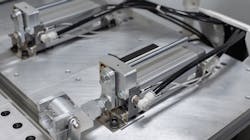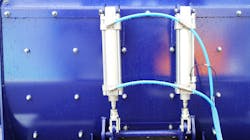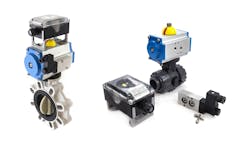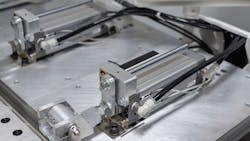Pneumatics is one of the two methods used to transmit power within the field of fluid power. While its counterpart hydraulics uses a liquid, pneumatics utilizes gas to move power from one location to another.
Compressed air is typically used for pneumatic systems, but nitrogen and other inert gases can also be used depending on the application requirements. A typical pneumatic system uses a compressor to pump air into a receiver which is able to hold a large volume of air to then be used by the system when needed.
Although hydraulics is known for its higher power density, pneumatics offers its own benefits and is a widely used technology. “Usually, it comes down to total cost of ownership. If you don't need the heavy loads possible with hydraulics, you can still get high speed with pneumatics but lower total cost of ownership,” explained Jon Jensen (no relation to author), CFPPS, CFPECS & CFPAI, Industry Projects Manager – Energy at SMC Corporation of America in an interview with Power & Motion.
When deciding whether to use pneumatics or hydraulics, there are several factors to take into consideration.
READ MORE: Robots and Cobots Present Opportunity for Pneumatics
Determine Load and Speed Requirements
According to Jensen, the lower cost and longevity of pneumatic components can make them a more desirable option than hydraulic or electric actuators in many applications. The amount of force required in an application is the key determining factor for choosing pneumatics or hydraulics. “Generally, the added cost of hydraulics is not needed unless the forces are higher,” said Jensen. “If you’re moving things in the range of a few pounds then pneumatics is a good choice.”
He noted hydraulics typically come into play when loads reach several hundred pounds or more as at that point it does not work well to move something pneumatically. Control is better within hydraulic systems because the fluid does not compress which is beneficial when moving something heavy as it prevents jerking or bouncing while moving.
Pneumatics are an appropriate choice for applications with lower load requirements. Again, they can provide a cost-effective solution, among other benefits. Because pneumatics components are designed to operate at lower pressures they are not as expensive to manufacture as hydraulic components.
Industrial pneumatics use a centralized compressor to supply a whole facility whereas hydraulic systems feature individual pumps and motors and are set up on a machine-by-machine basis which factors into operational costs. “You have the cost of multiple motors and pumps, or engines in the case of mobile hydraulics,” said Jensen. This can lead to more time spent on maintenance, repair parts and other operational costs.
When looking at other options available today such as electric actuation or electric motors, he said the up-front costs are generally higher. Loads and speeds are a factor to consider with these options as well because there comes a point with electric actuators at which making them larger becomes cost prohibitive and it would make more sense to instead use hydraulics.
Weigh the Pros and Cons
Durability is another key benefit offered by pneumatics as they do not break down very often. Jensen said they tend to fail gradually and can start leaking but still work for years. When they do leak, it is usually not as much of an issue as with hydraulics as air will not contaminate the environment like oil does. The one caveat is if the pneumatics system is being used in a cleanroom; then the leaking of air could cause a contamination issue in these sensitive environments. But in general, he said the use of air makes pneumatics a clean technology.
Like any technology, pneumatics is not without its challenges one of which is the fact these systems use compressed air which Jensen said can make them “a little more interesting to deal with.” A common issue is low pressure or the perception there is low pressure. If there is not enough pressure moving through the system performance issues can arise. But it is important to determine the actual cause of that lower pressure so the appropriate fix can be made.
Another challenge Jensen noted is the fact system leaks may be ignored. “Because leakage is not usually a catastrophe or environmental hazard, it is often ignored.” While this may not impact productivity it can negatively affect efficiency and ultimately operational costs. This is an issue the industry attempts to address through technology developments and use of monitoring systems.
Additional factors which should be kept in mind with pneumatics is the cost of compressed air as it is costly, said Jensen, as well as a less efficient means of transmitting power than hydraulics or direct mechanical systems such as electric motors.
However, despite some of these challenges, he said the various benefits pneumatics provide makes them an attractive option in many cases. “It's still a widely used and accepted means of transmitting power, especially in factory automation, packaging and other applications like that where speeds are high, but forces and loads are comparatively low,” said Jensen. “If you added it all up, total cost of ownership is still attractive even though efficiency is [lower].”
Right Size the System
If choosing to use pneumatics, what are some considerations design teams should keep in mind? According to Jensen, right sizing the pneumatic system is vital to ensuring its efficiency. All components in the system need to be sized correctly, he said.
A common practice has been oversizing components "just in case" but Jensen said that leads to larger volumes to fill which makes a system less efficient. Even the size of tubing and hoses needs to be considered because the more volume that needs to be filled the higher the operating costs. As such, it is important to be “very particular about sizing things correctly,” he said.
Another suggested best practice is to not run everything at the same pressure. This means designing the system so the correct pressure for each part of the machine is adjusted and maintained. If something is moving it does not usually need the same force in both directions. “Usually, it’s pushing something and then pulling back and not doing any work,” said Jensen. “We can adjust the pressure and often reduce the cost of the air by 50% for that application. There are a lot of little things you can do that add up to real efficiencies.”
In general, he said it is important to get pressure and flow in the right place and for end users to monitor them both to ensure efficient operation.
This article is part of Power & Motion's Fundamentals of Fluid Power: Pneumatics ebook; download the full guide to learn about the latest technologies and design methods for developing modern pneumatic systems.
About the Author
Sara Jensen
Executive Editor, Power & Motion
Sara Jensen is executive editor of Power & Motion, directing expanded coverage into the modern fluid power space, as well as mechatronic and smart technologies. She has over 15 years of publishing experience. Prior to Power & Motion she spent 11 years with a trade publication for engineers of heavy-duty equipment, the last 3 of which were as the editor and brand lead. Over the course of her time in the B2B industry, Sara has gained an extensive knowledge of various heavy-duty equipment industries — including construction, agriculture, mining and on-road trucks —along with the systems and market trends which impact them such as fluid power and electronic motion control technologies.
You can follow Sara and Power & Motion via the following social media handles:
X (formerly Twitter): @TechnlgyEditor and @PowerMotionTech
LinkedIn: @SaraJensen and @Power&Motion
Facebook: @PowerMotionTech

Leaders relevant to this article:




